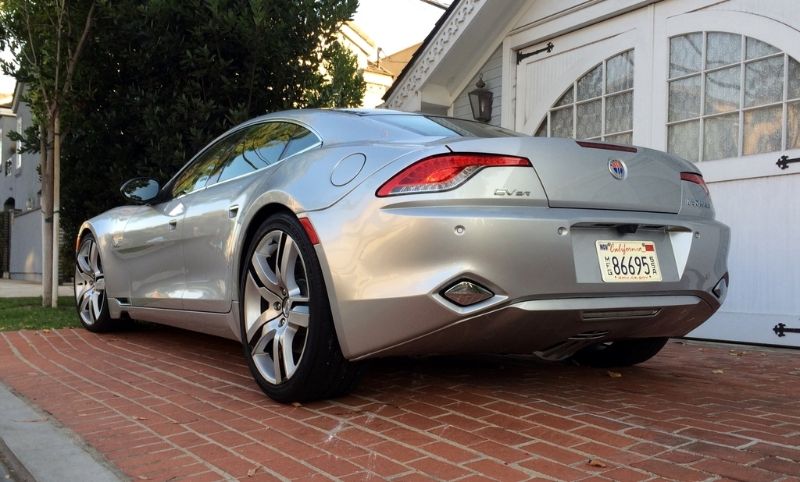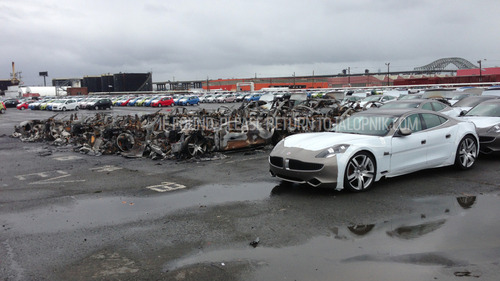Quote:
Inside the Fisker Karma’s Impossible Return From Automotive H#ll
Carl Jenkins just wanted to go for a drive. The San Bernardino Mountains promised stunning alpine vistas and breathtaking views of reservoirs and lakes, and weren’t too far from his Southern California home. So on a nice Saturday afternoon in July of 2015, Jenkins and his wife set out in his new hybrid electric Fisker Karma.
They made it three miles up the canyon road before the dreaded dashboard lights blinked on: The car had overheated. “I ended up with a classic picture of my wife standing next to this gorgeous car, in gorgeous scenery, with the hood up and coolant just pouring out of it,” Jenkins says.
Back at work Monday morning, Jenkins got right to griping, like you’d expect from someone who’d lost a nice weekend to a shoddy product. But he wasn’t moaning to a sympathetic cubicle mate. Jenkins leads the engineering efforts at Karma Automotive.
Quote:
You might remember Fisker. The company had once threatened to upend Detroit with a sleek, eco-minded sports car—and then crashed in a blaze of mismanagement and bad luck. Jenkins was supposed to resurrect its only product, the Karma.
That drive on the Rim of the World Scenic Byway, during his first weekend at the company, crystalized just how difficult it would be. He called in the thermal team for a blunt conversation—one of many.
Three weeks after the weekend jaunt, the thermal folks had reworked the airflow through the front of the car, a simple fix the original engineers had overlooked as they raced to market in 2011. But it was just one of hundreds of issues Jenkins and his teams had to identify.
Quote:
But Fisker hadn’t run an automaker before. The company’s outsource-everything, low-headcount approach yielded a car riddled with engineering problems.
As the Karma went from concept to reality and kept missing deadlines, the headlines soured: Poor reliability! Electrical fires! Late loan payments! The price of the Karma steadily rose. Fisker first announced an MSRP around $80,000. By production time, it started at six figures.
As Fisker ran through cash and missed deadlines, the DOE quietly froze its funding in May 2011; it had doled out nearly $200 million. Desperate to keep cash flowing, Fisker started selling vehicles too quickly, before properly addressing the Karma’s myriad problems.
“Really they launched the vehicle a year too soon,” says Jenkins. “They didn’t finish the program.”
Quote:
The company was working at the forefront of automotive technology. Fisker had to teach his suppliers how to make some necessary components. When his sole battery supplier, Massachusetts-based A123, went bust, “that was a disaster for us,” he says.
Fisker Automotive went bankrupt in 2013.
https://www.wired.com/2016/08/fisker-karma-automotive-revero
Inside the Fisker Karma’s Impossible Return From Automotive H#ll
Carl Jenkins just wanted to go for a drive. The San Bernardino Mountains promised stunning alpine vistas and breathtaking views of reservoirs and lakes, and weren’t too far from his Southern California home. So on a nice Saturday afternoon in July of 2015, Jenkins and his wife set out in his new hybrid electric Fisker Karma.
They made it three miles up the canyon road before the dreaded dashboard lights blinked on: The car had overheated. “I ended up with a classic picture of my wife standing next to this gorgeous car, in gorgeous scenery, with the hood up and coolant just pouring out of it,” Jenkins says.
Back at work Monday morning, Jenkins got right to griping, like you’d expect from someone who’d lost a nice weekend to a shoddy product. But he wasn’t moaning to a sympathetic cubicle mate. Jenkins leads the engineering efforts at Karma Automotive.
Quote:
You might remember Fisker. The company had once threatened to upend Detroit with a sleek, eco-minded sports car—and then crashed in a blaze of mismanagement and bad luck. Jenkins was supposed to resurrect its only product, the Karma.
That drive on the Rim of the World Scenic Byway, during his first weekend at the company, crystalized just how difficult it would be. He called in the thermal team for a blunt conversation—one of many.
Three weeks after the weekend jaunt, the thermal folks had reworked the airflow through the front of the car, a simple fix the original engineers had overlooked as they raced to market in 2011. But it was just one of hundreds of issues Jenkins and his teams had to identify.
Quote:
But Fisker hadn’t run an automaker before. The company’s outsource-everything, low-headcount approach yielded a car riddled with engineering problems.
As the Karma went from concept to reality and kept missing deadlines, the headlines soured: Poor reliability! Electrical fires! Late loan payments! The price of the Karma steadily rose. Fisker first announced an MSRP around $80,000. By production time, it started at six figures.
As Fisker ran through cash and missed deadlines, the DOE quietly froze its funding in May 2011; it had doled out nearly $200 million. Desperate to keep cash flowing, Fisker started selling vehicles too quickly, before properly addressing the Karma’s myriad problems.
“Really they launched the vehicle a year too soon,” says Jenkins. “They didn’t finish the program.”
Quote:
The company was working at the forefront of automotive technology. Fisker had to teach his suppliers how to make some necessary components. When his sole battery supplier, Massachusetts-based A123, went bust, “that was a disaster for us,” he says.
Fisker Automotive went bankrupt in 2013.
https://www.wired.com/2016/08/fisker-karma-automotive-revero






